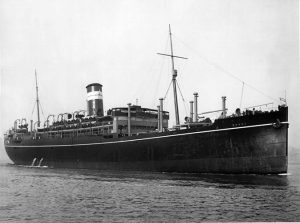Lecture to relate the largely untold story of the men lost on HMT Rohna in 1943
December 6, 2022On Nov. 26, 1943, HMT Rohna – HMT for His Majesty’s Transport – was attacked by German aircraft in the Mediterranean off North Africa. She was hit by a Henschel Hs 293 guided glide bomb – a sort of science-fiction device at the time – and sank.
A total of 1,138 men were killed aboard the British vessel, and 1,015 of them were American servicemen. It would be a long time before any of their loved ones on the home front learned what had happened.
Catherine Ladnier will tell the story of the Rohna at noon on Friday, Dec. 16, at the South Carolina Confederate Relic Room and Military Museum in Columbia. The program will be open to the public, and free.
Some Columbians will remember Ms. Ladnier from when she lectured at the Relic Room on a different subject on Feb. 25. That program was called, “‘Harry, I would have written sooner but I was too damned drunk, Love Cleta:’ Rosie the Riveters’ Letters to a Soldier, 1942-45.”
That very different subject arose from the same source – a trove of old letters Catherine found in her mother’s house in Easley after her mother passed away in 2001.
She learned about the Rohna from a mimeographed letter that her family had received from a woman whose husband had been reported missing when Rohna sank. Mary Leach had learned that a couple of other families had received similar notifications about officers in the Army’s 853rd Aviation Engineer Battalion, and she was reaching out in a desperate effort to learn what had happened.
Her husband Fred was good friends with a man named William George Brown from South Carolina. That was Catherine Ladnier’s Uncle Bill, which is why her family had received the letter. He, too, served in the 853rd, which had been formed at Dyersburg, Tenn., earlier that same year. They had been on their way to India to build airfields for the Pacific war when Rhona sank.
Uncle Bill had survived the Rohna’s sinking, but survivors were under strict orders not to tell anyone what had happened. Of course, in that war, all letters home were censored. Soldiers weren’t allowed to tell their families where they were or what they were doing. But there was a special sensitivity about this, the most deadly loss of soldiers at sea in U.S. history. There was also the problem of the new, high-tech weapon the Germans had used, and uncertainty about whether the enemy knew how successful it had been.
As it happened, Uncle Bill wrote to his wife anyway, and told the story in great detail. Somehow it got past the censors. But still, back in America, very few knew what had happened. It would be 1947 before a newspaper reported that the ship had been sunk by a “radio-controlled [sic] glider bomb.” And yet every state in the union except Montana had lost sons. South Carolina lost five.
When she learned about it 35 years after the fact, Catherine threw herself into learning more, and telling the story. She speaks regularly on the subject, and is actively involved in the Rohna Survivors Memorial Association, which meets annually and is preparing for next year’s 75-year commemoration of the sinking.
Catherine grew up in Southern California, but her mother was from South Carolina, and over the years she has visited here often. She is a graduate of Mills College and Harvard University, and works as a securities compliance consultant. She and her husband, Mickey Robinson, serve on the President’s Advisory Council of the National Wildlife Federation. Her family have turned her mother’s ancestral land in the Upstate into the Nalley Brown Nature Park.
About the South Carolina Confederate Relic Room and Military Museum
Founded in 1896, the South Carolina Confederate Relic Room and Military Museum is an accredited museum focusing on South Carolina’s distinguished martial tradition through the Revolutionary War, Mexican War, Civil War, Spanish-American War, World Wars I and II, Vietnam, the War on Terror, and other American conflicts. It serves as the state’s military history museum by collecting, preserving, and exhibiting South Carolina’s military heritage from the colonial era to the present, and by providing superior educational experiences and programming. It recently opened a major new exhibit, “A War With No Front Lines: South Carolina and the Vietnam War, 1965-1973.” The museum is located at 301 Gervais St. in Columbia, sharing the Columbia Mills building with the State Museum. For more information, go to https://crr.sc.gov/.














